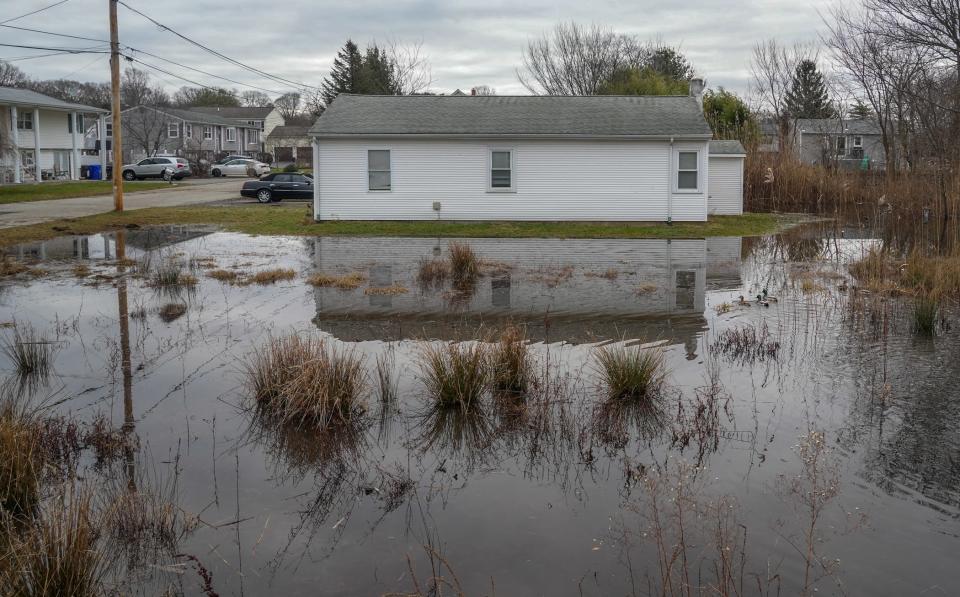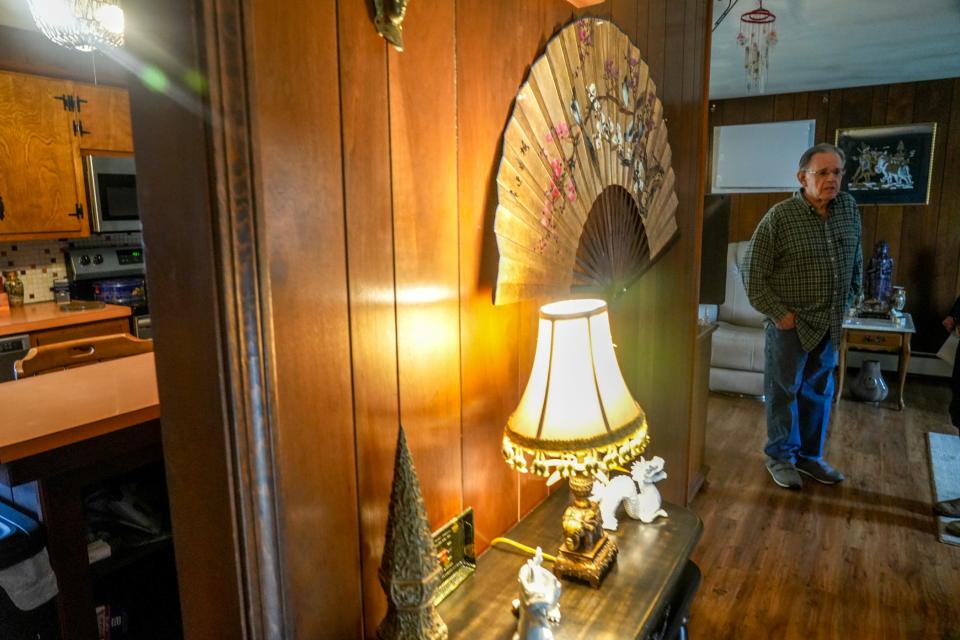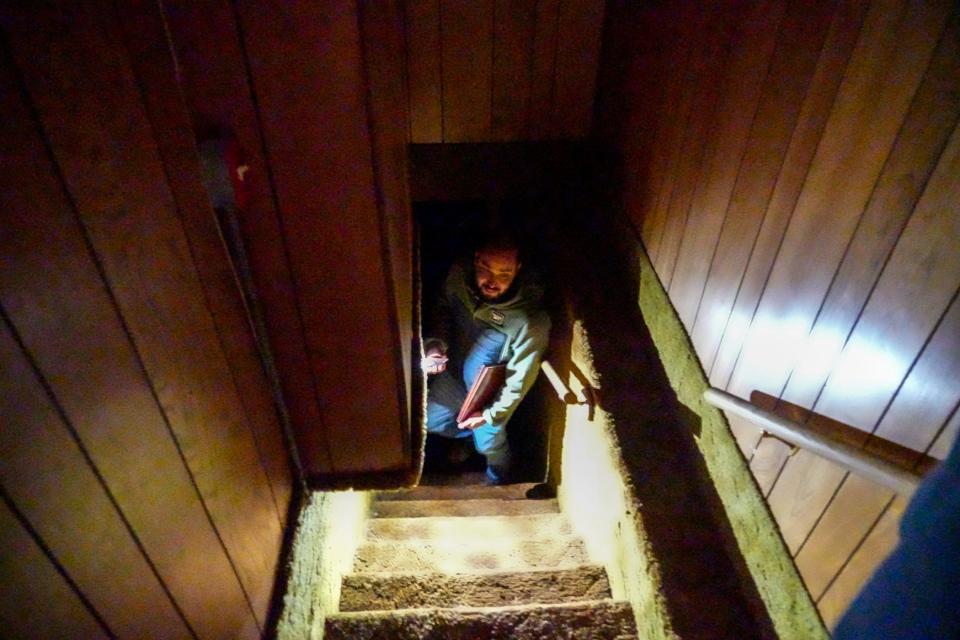In retreat from rising waters, RI steps in to buy out flood-prone homes
EAST PROVIDENCE – For Kathy Ribeiro, last week’s rainstorm was a timely reminder of why she sold her house and moved out of the flood-prone neighborhood where she'd lived for 21 years.
Keeping the basement from filling with water was a constant battle. Ribeiro had four sump pumps running around the clock every day.
“I’m relieved because I don’t have to fight anymore,” Ribeiro said.
Hers is one of 13 houses and five vacant lots near the Runnins River being bought with federal money as part of a floodplain restoration project. The houses will be torn down and the natural wetlands restored, with the goal of reducing chronic flooding in the Luther's Corner neighborhood.

Known also as buyouts or managed retreat, purchase programs to move people out of areas that have flooded repeatedly are becoming more common. One Rhode Island community is considering buying out more than 300 buildings in an area where rising seas and more frequent downpours are expected to make flooding worse. The federal government has large plans in the works for three watersheds in the state, including one area where 100 homes would be bought and demolished.
“The risks are growing as flooding becomes more frequent,” said Darrell Moore, state engineer with the Natural Resources Conservation Service. “It can be scary for homeowners.”
Ribeiro, a 55-year-old special education teacher, still thinks about all the work she put into the house on Abbott Street and all the memories of the life she built there with her late husband and their kids. But she knew she couldn’t keep Mother Nature at bay forever.
“You just cannot control the water in that area,” she said.

Downpours becoming more common
Weather data shows that Rhode Island is being hit with more big storms like the one last Tuesday that dumped up to 5 inches of rain in some parts of the state.
Since 1905, the average number of days per year in the Providence area with more than 1 inch of rain has increased from eight to 14, according to the Northeast Regional Climate Center at Cornell University. Last year, there were 18 such days, tied for seventh most on record.
The highest daily precipitation totals are also on the rise, increasing from 2.5 inches on average to 3.1 inches, according to the Cornell Center. The number for 2023 was 3.35 inches.
It’s not just that intense rainstorms are becoming more frequent in Rhode Island and the rest of the Northeast as the climate continues to change. Places are also starting to flood that were never affected before.
A Labor Day storm in 2022 shut down Interstate 95 in Providence as rain fell faster than the highway's storm drains could handle. The only other time in memory that the interstate had been cut off by floodwaters was during a historic series of storms in 2010. That flooding happened when the Pawtuxet River, swollen to capacity, spilled its banks. The more recent shutdown was due to so much rain falling in such a narrow window of time.
A similarly intense rainstorm flooded apartments and houses in Cranston and other parts of Providence County last September. Because almost none of the residences were in a known flood plain, only a handful had flood insurance, according to a recent state assessment of the damage.
'That house should never have been built there'
The cottage in Luther's Corner appeared to be sitting in the middle of a pond the morning after last Tuesday’s storm. By Thursday, some of the water had drained, but a group of ducks was happily paddling around the vacant house on Abbott Street that backs onto wetlands.

“That house should never have been built there,” Gina DeMarco said as she walked through the neighborhood near the Massachusetts state line.
DeMarco, special projects manager for the Northern Rhode Island Conservation District, is overseeing the project to purchase homes in the neighborhood on behalf of the Natural Resources Conservation Service, which is an arm of the U.S. Department of Agriculture.
Through its watershed protection program, the NRCS is authorized by the federal government to buy conservation protections for properties across the country and restore them as part of the natural floodplain.
Luther’s Corner qualified for the emergency section of the program after Tropical Storm Ida hammered Rhode Island in September 2021. It wasn’t the first time the neighborhood had flooded, but it was one of the worst.
East Providence applied for help from the NRCS and won approval for the project last year after U.S. Sen. Jack Reed secured nearly $8 million in funding for the purchases.
No one is being forced to leave the neighborhood. Indeed, many residents are staying. Some are elderly and are attached to homes they’ve lived in for decades, said DeMarco. Others live in homes that were built on fill. They sit up high enough that flooding isn’t as much of a problem.
The people who agreed to sell are being paid what’s considered fair market value, the result of two separate appraisals of each home. Nearly all the sales are complete. The houses will be torn down this spring.
By removing the structures and any fill, replanting the area and restoring it to its natural state, DeMarco, Moore and others working on the project hope they can reduce the threat of flooding for the houses that remain.
Relocation is a last resort
Buying homes and tearing them down is a last resort, but sometimes there’s no viable alternative.
Building drainage systems can cost many millions of dollars. Erecting flood protection walls can be even more expensive – and unsightly. And there’s no guarantee that concrete infrastructure projects will be able to handle some of the extreme flooding in the hardest-hit locations.
But there are also no guarantees that flooding will stop in neighborhoods where some houses are removed. DeMarco says she can only promise that the restoration work won’t make flooding worse. Moore says other houses will be less prone to flooding.
“Is it going to stop flooding? No,” he said. “But it’s going to give us a little more storage.”
Take Belfield Drive in Johnston, a neighborhood near the Pocasset River where the NRCS bought one house in 2021 and tore it down so the land could act as a retention area for floodwaters. In last week’s storm, residents still had to be evacuated by boat.
Without the $1.3-million project, the flooding would have been more severe, said Phou Vongkhamdy, state conservationist with the NRCS. But there were new blockages downriver that exacerbated the latest flooding.
“The massive amounts of water coming down to that area, there’s no engineering solution for that,” DeMarco said.
The reality is that some houses were simply built where they probably shouldn’t have been. DeMarco points to one of the streets in Luther’s Corner.
“Its name is Marsh Street,” she said. “That should be a big red flag.”
A witness to climate change

Ron Fiorito was one of the last homeowners to be approved for the Luther’s Corner program. He got word in December that the project partners would buy his raised ranch on Luther Street.
He’d lived in the house for only two years, but he was sick of having to mop up water in the finished lower level every time a heavy rain rolled through. He still had the wet-vac out Thursday morning after cleaning up three or four inches of water that seeped into the house during Tuesday’s storm. With another storm expected, he wasn’t ready to put it away.
Fiorito, a 73-year-old retired medical researcher, inherited the house from his parents. It flooded badly in the 2010 storms, and they had to be evacuated from the neighborhood by boat. But that was considered an isolated event, and Fiorito wasn’t too worried about flooding in August 2021 when he moved in.
A few weeks later, Ida swept through and the neighborhood flooded. It’s happened again and again since, and, in Fiorito’s experience, it's becoming more frequent.
“Every time it rains, my stomach gets in knots,” he said. “I’m afraid to go downstairs.”
Fiorito had been doubtful about climate change, but no more.
“I’m witnessing it,” he said. “I definitely believe in it now.”
He’s using the proceeds from the sale to buy a condo in Lincoln. It’s on the second floor, he pointed out.
Salvaging what they can from the soon-to-be demolished homes
One street over, a team from Habitat for Humanity was going through some of the 11 houses that have been vacated already.
DeMarco was hoping she’d be able to find a developer or nonprofit that would take the homes for free and move them somewhere else. She had no luck, so the next best thing was to salvage as much as possible of what remains in the houses.

When Stephanie Isenberg, a manager with Habitat for Humanity, got the call, she thought at first that DeMarco was offering houses that could be rehabbed for new families.
“But they’re all on wetlands,” Isenberg said.
So instead, on Thursday she and two colleagues went through the houses to catalog what they could save. The air was musty inside 95 Abbott St. when they opened the front door.
“Look at this kitchen,” remarked operations manager Steve Santos as he inspected the pristine countertops and cabinets. “What a shame. But we might be able to use them.”
General contractor Tito Nadal started down the steps to the basement to get a look at the boiler and other mechanical systems, but he couldn’t make it all the way. Water filled the basement, rising to cover the bottom steps.
Relocation projects are growing in number
Programs to get people out of flood-prone places aren’t new.
In the mid-1980s, 61 houses were razed in the Belmont Park neighborhood near the Pawtuxet River in Warwick. After the 2010 storms, more than 20 homes in Cranston, also close to the Pawtuxet, were bought and torn down.
But what’s being contemplated now is on a different scale than past initiatives. Town officials in Warren are working on a plan to relocate the entire neighborhood around Belcher Cove to higher ground.
The NRCS has emergency petitions pending for properties in Narragansett, Middletown and Johnston. Another for West Warwick is expected after Tuesday’s storm.
There are also three long-term projects that would be much larger than any of the emergency projects. They would be located in the Wood-Pawcatuck River watershed in Washington County, the Woonasquatucket River watershed in the greater Providence area, and around the Pocasset River in Johnston.
While it’s unclear how many homes could be targeted in the first two project areas, the Pocasset project has progressed the furthest in the planning process, and the funding goal has been set at $70 million, enough money to buy 100 homes. It would be the biggest NRCS project of its kind in the Northeast.
Reed has gotten $10 million for the project so far. Purchases could start as soon as this fall.
On a tour of some of the state’s flooding damage on Friday, Reed said communities need to make repairs but must also look at the long term.
“The step we want to take is not just fixing this but mitigating future climate incidents like this,” he said.
Moore says it’s unclear if it’s just an increased need that’s driving the number of new purchase projects, or if it’s a greater awareness among city and town governments that help is out there.
For the non-emergency projects, it’s a long road to implementation.
“It can take 10 years to go from the preliminary investigation to actually completing the project,” said Moore.
A bittersweet decision to leave
Built in the early 1900s, the two-family home where Ribeiro lived is believed to be the first house in Luther’s Corner. Her husband grew up there, and the two of them bought it from his parents in 2002 and raised their children there.
Ribeiro’s father-in-law told her that for years the house stood alone in the neighborhood and that flooding wasn’t an issue. It wasn’t until more houses were built and business were developed off nearby Waterman Avenue and upstream along the Runnins River in Seekonk, Massachusetts, that problems arose.
With more asphalt and rooftops, rainwater had fewer places to seep into the ground. Instead, it started running off streets and driveways and pooling in low areas.
But it’s not just rainfall that’s a problem. The water table is so high in the neighborhood that water constantly seeps into basements. Ribeiro’s sump pumps could barely keep up.
Selling wasn’t an easy decision. Although she doesn’t regret it, Ribeiro said it broke her heart to leave.
“That will always be my home,” she said.
This article originally appeared on The Providence Journal: Buyouts for flood prone homes in Rhode Island becoming more common
